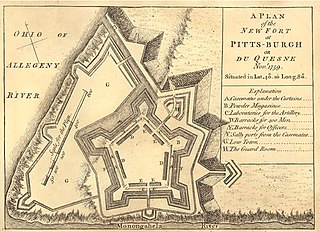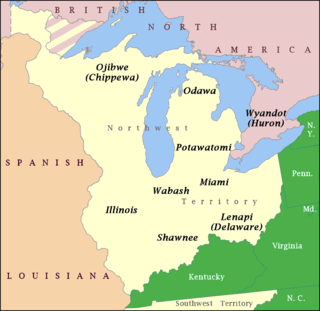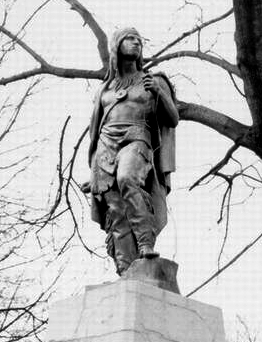
The Lenape, also called the Lenni Lenape and Delaware people, are an indigenous people of the Northeastern Woodlands, who live in the United States and Canada.

Pontiac's Rebellion was launched in 1763 by a loose confederation of Native Americans who were dissatisfied with British rule in the Great Lakes region following the French and Indian War (1754–1763). Warriors from numerous nations joined in an effort to drive British soldiers and settlers out of the region. The war is named after Odawa leader Pontiac, the most prominent of many indigenous leaders in the conflict.

The Province of Pennsylvania, also known as the Pennsylvania Colony, was a British North American colony founded by William Penn, who received the land through a grant from Charles II of England in 1681. The name Pennsylvania was derived from "Penn's Woods", referring to William's father Admiral Sir William Penn.

The Gnadenhutten massacre, also known as the Moravian massacre, was the killing of 96 pacifist Moravian Christian Indians by U.S. militiamen from Pennsylvania, under the command of David Williamson, on March 8, 1782, at the Moravian missionary village of Gnadenhutten, Ohio Country, during the American Revolutionary War.
Gelelemend (1737–1811) (Lenape), also known as Killbuck or John Killbuck Jr., was an important Delaware (Lenape) chief during the American Revolutionary War. He supported the rebel Americans, known as Patriots. His name signifies "a leader." He was born into the Turtle clan, which had hereditary responsibility for leadership, he became principal chief of the Lenape in November 1778, following the death of White Eyes, a war chief and Speaker of the Delaware Head Council. Gelelemend succeeded his maternal grandfather Netawatwees.

The western theater of the American Revolutionary War (1775–1783) was the area of conflict west of the Appalachian Mountains, the region which became the Northwest Territory of the United States as well as what would become the states of Kentucky, Tennessee, Missouri, and Louisiana. The western war was fought between American Indians with their British allies in Detroit, and American settlers south and east of the Ohio River, and also the Spanish as allies of the latter.

Fort Pitt was a fort built by British forces between 1759 and 1761 during the French and Indian War at the confluence of the Monongahela and Allegheny rivers, where the Ohio River is formed in western Pennsylvania. It was near the site of Fort Duquesne, a French colonial fort built in 1754 as tensions increased between Great Britain and France in both Europe and North America. The French destroyed Fort Duquesne in 1758 when they retreated under British attack.
White Eyes, named Koquethagechton, was Chief Sachem of the Lenape (Delaware) people in the Ohio Country during the era of the American Revolution. Sometimes known as George White Eyes, or Captain Grey Eyes al. Sir William, his given name in Lenape was rendered in many spelling variations in colonial records.
Buckongahelas together with Little Turtle & Blue Jacket, achieved the greatest victory won by Native Americans, killing 600. He was a regionally and nationally renowned Lenape chief, councilor and warrior. He was active from the days of the French and Indian War through the Northwest Indian Wars, after the United States achieved independence and settlers encroached on territory beyond the Appalachian Mountains and Ohio River. The chief led his Lenape band from present-day Delaware westward, eventually to the White River area of present-day Muncie, Indiana.
Shingas was a Lenape chief and warrior who participated in military activities in Ohio Country during the French and Indian War. Allied with the French, Shingas led numerous raids on Anglo-American settlements during the war, for which he was nicknamed "Shingas the Terrible" by the settlers. The colonial governments of Pennsylvania and Virginia responded to these raids by placing a bounty on Shingas.

The siege of Fort Pitt took place during June and July 1763 in what is now the city of Pittsburgh, Pennsylvania, United States. The siege was a part of Pontiac's War, an effort by Native Americans to remove the Anglo-Americans from the Ohio Country and Allegheny Plateau after they refused to honor their promises and treaties to leave voluntarily after the defeat of the French. The Native American efforts of diplomacy, and by siege, to remove the Anglo-Americans from Fort Pitt ultimately failed.

The Christian Munsee are a group of Lenape, an Indigenous people in the United States, that primarily speak Munsee and have converted to Christianity, following the teachings of Moravian missionaries. The Christian Munsee are also known as the Moravian Munsee or the Moravian Indians, the Moravian Christian Indians or, in context, simply the Christian Indians. As the Moravian Church transferred some of their missions to other Christian denominations, such as the Methodists, Christian Munsee today belong to the Moravian Church, Methodist Church, United Church of Canada, among other Christian denominations.

The Crawford expedition, also known as the Sandusky expedition and Crawford's Defeat, was a 1782 campaign on the western front of the American Revolutionary War, and one of the final operations of the conflict. The campaign was led by Colonel William Crawford, a former officer in the U.S. Continental Army. Crawford's goal was to destroy enemy Native American towns along the Sandusky River in the Ohio Country, with the hope of ending Native attacks on American settlers. The expedition was one in a series of raids against enemy settlements that both sides had conducted throughout the war.

The Northwestern Confederacy, or Northwestern Indian Confederacy, was a loose confederacy of Native Americans in the Great Lakes region of the United States created after the American Revolutionary War. Formally, the confederacy referred to itself as the United Indian Nations, at their Confederate Council. It was known infrequently as the Miami Confederacy since many contemporaneous federal officials overestimated the influence and numerical strength of the Miami tribes based on the size of their principal city, Kekionga.

Captain Pipe (Lenape), called Konieschquanoheel and also known as Hopocan in Lenape, was an 18th-century Head Peace chief of the Algonquian-speaking Lenape (Delaware) and War Chief 1778+. He succeeded his maternal uncle Custaloga as chief by 1773. Likely born in present-day Pennsylvania, he later migrated with his people into eastern Ohio.
George Morgan was a merchant, land speculator, and United States Indian agent during the American Revolutionary War, when he was given the rank of colonel in the Continental Army. He negotiated with Lenape and other Native American tribes in western Pennsylvania to gain their support during the American Revolutionary War. An associate of the Lenape chief White Eyes, Morgan cared for his son George Morgan White Eyes for several years after White Eyes died.

Daniel Brodhead was an American military and political leader during the American Revolutionary War and early days of the United States.

Turtleheart was a Delaware (Lenape) principal warrior and chief who lived during the French and Indian Wars, and Pontiac's War. He and Lenape Chief Killbuck represented the Delaware Nation at the Treaty of Fort Stanwix in 1768.

Kuskusky, also known as the Kuskuskies Towns, Kuskuskie Towns, or Kuskuskies' Indian Town, with a wide variety of other spellings, were several Native American communities inhabited near New Castle, Mahoning, and Edinburg, Pennsylvania, and Youngstown, Ohio, during the mid-18th century. It was not one town, but three or four contiguous towns of the Mingoes, Lenape, and Seneca, located along the Beaver River, at and above the junction of its east and west branches, the Mahoning River and the Shenango River. It is usually referred to in the plural.

Tamaqua or Tamaque, also known as The Beaver and King Beaver, was a leading man of the Unalachtigo (Turkey) phratry of the Lenape people. Although the Iroquois in 1752 had appointed Shingas chief of the Lenape at the Treaty of Logstown, after the French and Indian War Tamaqua rose in prominence through his active role as peace negotiator, and was acknowledged by many Lenape as their "king" or chief spokesman. He was among the first to hand over English captives at the end of the French and Indian War and was active in peace negotiations at the conclusion of Pontiac's War. By 1758, he was recognized as one of three principal leaders of the Lenape, being the primary spokesman for the western Lenape in the Ohio Country. He founded the town of Tuscarawas, Ohio, in 1756 and died there in 1769 or 1771.














